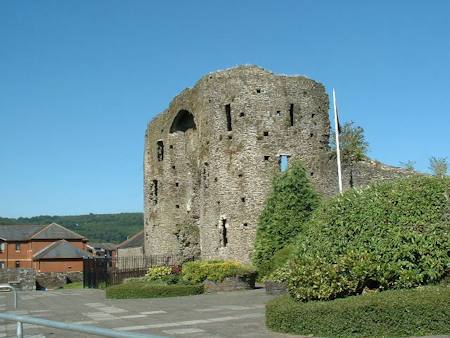
Neath Castle
Neath Castle sits in the centre of the town of Neath. Originally it was a timber castle, but it was quickly upgraded to stone in the face of Welsh attacks. It is a former stronghold of the unpopular Hugh le Despenser the Younger who was captured nearby.
A Town of Two Castles
In the early medieval period Neath actually had two castles. The town was never very big, but it sat at a key crossing point on the River Neath. The river was navigable and the crossing point at Neath had been in use since Roman times.
The first castle was constructed by Richard de Granville in, or very close to, the ancient Roman fort of Nidum. The exact date for its construction is unclear, but it was probably sometime in the 1120s.
It was abandoned quite quickly. Richard founded Neath Abbey next to it and the castle may have been used as a source of material for the new building. It was certainly gone by the 13th Century and nothing remains of it today.
The second castle was built at some point in the mid-12th Century. Again it’s unclear exactly when it was constructed. It was first mentioned in records dating to 1183. It sits in an elevated position on the east bank of the river, controlling the crossing.
Neath Castle became one of the numerous castles under the control of the Lords of Glamorgan. As such, it was a target for Welsh resistance and attacks. Llywelyn the Great attacked in 1231, after which the castle was rebuilt in stone by Richard de Clare.
Hugh le Despenser the Younger
In the late 13th Century Neath Castle came in to the possession of Sir Hugh le Despenser the Younger via his marriage to Eleanor de Clare. He was a royal courtier and a favourite of King Edward II of England. His greed and ruthlessness made him unpopular and he had a long list of enemies, including Queen Isabella herself.
In 1321 that came to roost as Hugh was exiled and Neath was captured along with his other properties. The barons took their revenge out on Glamorgan and undertook a 10 day raid that damaged much of the area.
When he came back from his exile in 1322 it is thought that Hugh re-fortified Neath Castle. The twin-towered gatehouse that forms the bulk of the ruins we see today is thought to have been his.
The layout inside is fairly straightforward. The gatehouse sits to the west and would have led in to a small inner courtyard. You can still see some of the foundations of the domestic buildings that would have lined its walls. To the east are the remnants of the U-shaped keep.
Neath Castle continued to be used as a fortification until the 17th Century. In the 18th Century it was a recreation area for the town.
Neath expanded radically during the Industrial Revolution and cottages and other buildings were constructed right up to the castle walls.
Modern Day
Today Neath Castle is looked after by Neath Town Council. There are no facilities specifically at the castle; however it sits very close to the town centre and all its amenities.
It is not possible to get inside the castle, but the exterior is freely accessible.
Neath Abbey sits nearby and is under the care of Cadw, who are currently undertaking a programme of works to preserve and consolidate it.
Status: Ruin / Historic Site
Opening Times: Exterior freely accessible


Neath castle gatehouse